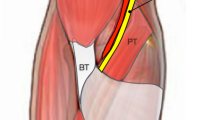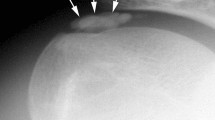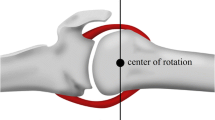Abstract
Transosseous repair of a supraspinatus tendon (SSP) defect (Patte size II) can be difficult if the tendon is retracted and the muscle atrophied. In this situation alternatives are margin convergence techniques, local tendon transfers or distant tendon transfers in massive tears. The object of this study was to compare two local tendon transfers in terms of the feasibility of the shift, the area covered by the shift and the force needed to accomplish the shift. Thirteen fresh-frozen cadaver shoulders were used. First a supraspinatus defect extending to the apex of the humeral head (Patte size II) was created. Transosseous repair was attempted with the infraspintus (ISP) and with the subscapularis (SCP) in all cases; repair was successful in all ISP cases, while use of the SCP resulted in a successful repair in only 8 of the 13 (61.5%). A significantly (P=0.012) larger defect area was covered by the ISP transfer than by the SCP shift: 89.7±8.5% versus 31.2±31.1% of the original defect, respectively. The tensile force needed to accomplish the shift was significantly (P=0.004) lower when the ISP was used (15±11 N) than with the SCP (37.1±15 N). In this cadaver model the ISP shift proved more favourable than the SCP shift for covering a Patte size II SSP defect.
Résumé
La réinsertion transosseuse du tendon du sus épineux (SSP) (Patte II) peut être difficile si le tendon est rétracté et le muscle atrophié. Dans ces conditions il faut utiliser une chirurgie de rapprochement des bords et des transferts tendineux dans les ruptures massives. Le but de cette étude est de comparer deux techniques de transferts tendineux, en termes de faisabilité, avec étude de la surface couverte par glissement et la force nécessaire pour accomplir celui-ci. 13 épaules de cadavres ont été utilisées, une perte de substance a été créée dans le sus épineux à l’apex de la tête humérale (Patte II). Une réparation transosseuse a été réalisée avec le tendon du sous épineux du sous scapulaire. La réparation a été possible dans tous les cas avec utilisation du sous épineux mais, seulement dans 8 cas sur 13 lorsqu’on a utilisé le sous scapulaire (61,5%). Un defect beaucoup plus large, peut être couvert par un lambeau du sous épineux plutôt que par un lambeau du sous scapulaire (89,7±8,5% versus 31,2±31,1%) du défect. La force nécessaire pour accomplir cette translation est significativement plus basse avec le sous épineux qu’avec le sous scapulaire (15±11 N versus 37,1±15 N). Un lambeau de rapprochement sous épineux semble plus favorable qu’un glissement sous scapulaire pour couvrir les pertes de substances Patte type II du sus épineux.




Similar content being viewed by others
References
Blaine TA, Freehill MQ, Bigliani LU (2001) Technique of open rotator cuff repair. Instr Course Lect 50:43–52
Boileau P, Brassart N, Watkinson DJ, Carles M, Hatzidakis AM, Krishnan SG (2005) Arthroscopic repair of full-thickness tears of the supraspinatus: does the tendon really heal? J Bone Joint Surg Am 87:1229–1240
Burkhart SS (2001) Arthroscopic treatment of massive rotator cuff tears. Clin Orthop Relat Res 390:107–118
Burkhart SS (2004) The principle of margin convergence in rotator cuff repair as a means of strain reduction at the tear margin. Ann Biomed Eng 32:166–170
Burkhart SS, Danaceau SM, Pearce CEJ (2001) Arthroscopic rotator cuff repair: analysis of results by tear size and by repair technique—margin convergence versus direct tendon-to-bone repair. Arthroscopy 17:905–912
Cofield RH (1982) Subscapular muscle transposition for repair of chronic rotator cuff tears. Surg Gynecol Obstet 154:667–672
Cofield RH, Parvizi J, Hoffmeyer PJ, Lanzer WL, Ilstrup DM, Rowland CM (2001) Surgical repair of chronic rotator cuff tears. A prospective long-term study. J Bone Joint Surg Am 83:71–77
Debeyre J, Patte D, Elmelik E (1965) Repairs of ruptures of the rotator cuff of the shoulder. With a note on advancement of the supraspinatus muscle. J Bone Joint Surg Br 47:36–42
Galatz LM, Griggs S, Cameron BD, Iannotti JP (2001) Prospective longitudinal analysis of postoperative shoulder function: a ten-year follow-up study of full-thickness rotator cuff tears. J Bone Joint Surg Am 83:1052–1056
Gazielly DF, Gleyze P, Montagnon C (1994) Functional and anatomical results after rotator cuff repair. Clin Orthop 304:43–53
Gerber C, Hersche O (1997) Tendon transfers for the treatment of irreparable rotator cuff defects. Orthop Clin North Am 28:195–203
Goutallier D, Postel JM, Gleyze P, Leguilloux P, Van Driessche S (2003) Influence of cuff muscle fatty degeneration on anatomic and functional outcomes after simple suture of full-thickness tears. J Shoulder Elbow Surg 12:550–554
Halder AM, Zhao KD, Odriscoll SW, Morrey BF, An KN (2001) Dynamic contributions to superior shoulder stability. J Orthop Res 19:206–212
Herzberg G (1995) Anatomical bases of musculotendinous transfers about the shoulder. University of Lyon (unpublished data)
Kasten P, Loew M, Rickert M (2006) Intramuscular lengthening and range of motion after local tendon transfer for repair of retracted supraspinatus tendon defects. A biomechanical study. Orthopade 35:102–106
Loehr JF, Helmig P, Sojbjerg JO, Jung A (1994) Shoulder instability caused by rotator cuff lesions. An in vitro study. Clin Orthop Relat Res 304:84–90
Motycka T, Kriegleder B, Landsiedl F (2001) Results of open repair of the rotator cuff–a long-term review of 79 shoulders. Arch Orthop Trauma Surg 21:148–151
Neer CS (1983) Impingement lesions. Clin Orthop 173:70–77
Neviaser JS (1971) Ruptures of the rotator cuff of the shoulder. New concepts in the diagnosis and operative treatment of chronic ruptures. Arch Surg 102:483–485
Ozbaydar MU, Tonbul M, Yurdoglu C, Yalaman O (2005) Arthroscopic-assisted mini-open repair of rotator cuff tears. Acta Orthop Traumatol Turc 39:121–127
Patte D (1990) Classification of rotator cuff lesions. Clin Orthop Relat Res 254:81–86
Pavlidis T, Ganten M, Lehner B, Dux M, Loew M (2003) Tenoplasty of the long head of the biceps in massive rotator cuff tear. Z Orthop Ihre Grenzgeb 141:177–181
Pfahler M, Branner S, Refior HJ (1999) Complete rotator cuff rupture–differential surgical techniques and intermediate-term results. Z Orthop Ihre Grenzgeb 137:295–300
Rockwood CA Jr, Williams GR Jr, Burkhead WZ Jr (1995) Debridement of degenerative, irreparable lesions of the rotator cuff. J Bone Joint Surg Am 77:857–866
Ruotolo C, Nottage WM (2002) Surgical and nonsurgical management of rotator cuff tears. Arthroscopy 18:527–531
Severud EL, Ruotolo C, Abbott DD, Nottage WM (2004) All-arthroscopic versus mini-open rotator cuff repair: a long-term retrospective outcome comparison. Arthroscopy 19:234–238
Warner JJP (2000) Management of massive irreparable rotator cuff tears: the role of tendon transfer. J Bone Joint Surg Am 82:878
Author information
Authors and Affiliations
Corresponding author
Rights and permissions
About this article
Cite this article
Kasten, P., Loew, M. & Rickert, M. Repair of large supraspinatus rotator-cuff defects by infraspinatus and subscapularis tendon transfers in a cadaver model. International Orthopaedics (SICO 31, 11–15 (2007). https://doi.org/10.1007/s00264-006-0142-7
Received:
Revised:
Accepted:
Published:
Issue Date:
DOI: https://doi.org/10.1007/s00264-006-0142-7




